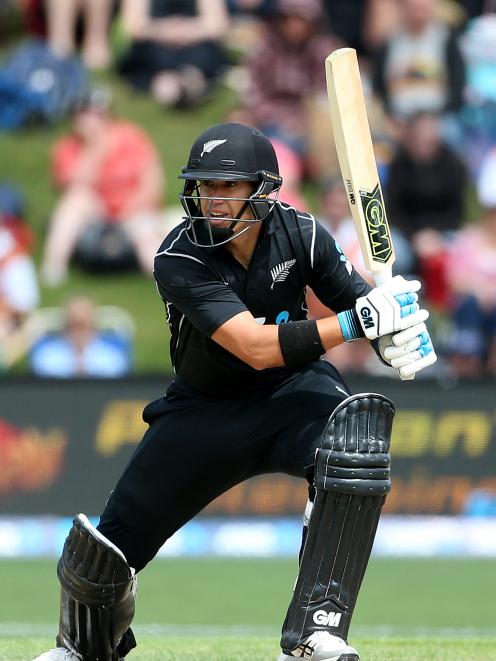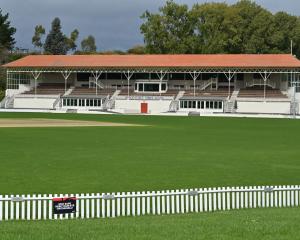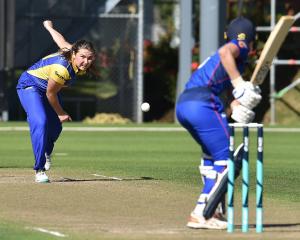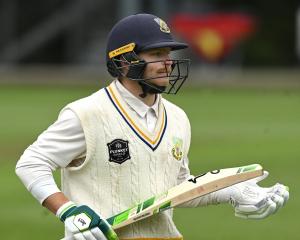
I only changed my gloves during an innings if I absolutely had to, for instance if I’d ripped them diving to avoid being run out. That was probably superstition, but then at what point does your routine become superstition? The way I looked at it was that, as a batter, there was only so much you can control: you react to and have to deal with what the bowler presents. I could control my mind and my preparation, all the way down to the order in which I put my gear on.
Superstition is all cause and effect. You have such and such for breakfast, you get runs, you keep having such and such for breakfast. If I made runs, I’d try to replicate pretty much everything next time around. And vice versa: if I failed, I did things differently next time.
I went through a phase during which [wife] Victoria had to book my haircuts. I’d rung the hairdresser, I’d got a duck, I made a connection. Once you’ve planted that seed in your mind, it’s hard to get rid of. That particular superstition snowballed to the point where I had to pay the hairdresser in cash. Thankfully, I got over it. New socks became my go to: Martin Guptill was the first to notice that, if I didn’t make runs, I’d wear brand new socks next time I batted.
The night before my first ever World Cup Game — against England in Saint Lucia in 2007 — Victoria and I went to a Chinese restaurant. I had crispy aromatic duck, one of my favourite meals. Liam Plunkett bowled me a fullish outswinger first ball; I went for the big cover drive, nicked it and Andrew Flintoff took a one-handed diving catch. Rule number one: don’t have duck the night before a game.
Mind you, Freddie had an even worse day than I did: he also got a golden duck, didn’t take a wicket and England got hammered. About 1.30am he decided it would be a good idea to have a nightcap with Ian Botham, who was staying on a boat out in the bay. Freddie commandeered a pedalo, put to sea and had to be rescued by hotel staff. He woke up the next morning, still wet and with sand between his toes, to the sound of his irate coach, Duncan Fletcher, pounding on the door.
Years later, we went to a degustation dinner that included duck. I said I couldn’t have the duck because I was playing in two days’ time. Our friends persuaded me the rule only applied when I was playing the next day. So, I had some duck and, sure enough, two days later I got a golden.
In late 2019 we were in Mount Maunganui to play England. We were staying in apartments, so at 7.30 the night before the game I was in a New World getting Weet-Bix and yoghurt for breakfast. It suddenly hit me that I’d forgotten to pack my batting trousers. We were moving house and, amid the disruption, I’d left home without the two pairs of batting trousers that I’d alternated between over the course of 100 tests. (It was amazing they’d lasted that long given how hard on clothes some hotel laundries are.)
I rang Victoria to explore the possibility of her meeting me halfway. She didn’t spend a lot of time thinking about it: I got a very firm "No way", which wound me up massively. I rang Sky commentator Simon Doull, who also lives in Hamilton, but he was already at the Mount. There was no choice but to drive home. I was in the Kaimais when Victoria rang to say the Northern Districts CEO was coming over in the morning and could bring my trousers. But I was halfway there and not receptive to compromises or olive branches, so I kept going. I got back to the Mount about 11pm and was so wide awake I didn’t get to sleep till midnight. Then Joe Root won the toss and chose to bat, so I didn’t even need the trousers.
It shows how mentally all over the place I was during the England series leading into the World Test Championship final that, for the first time in my test career, I didn’t wear either of those pairs of batting trousers in the second innings at Lord’s. You could call it clutching at straws, but that’s how desperate my search for runs had become. Having said that, I don’t think I would have had the nerve to do it in the first innings, in case I got a duck and was on a pair.
As I said, there’s superstition and there’s routine. When the wicket fell and it was my turn to bat, I’d pick up my gloves and my drink bottle, have three sips, put the drink bottle down, put my helmet on, grab my bat and walk out. When Jeff Crowe, Martin’s brother and an experienced ICC match referee, came to dinner, he revealed that, when I was going out to bat, the match officials added on a minute to ensure the fielding team didn’t get unfairly penalised. Apparently, it was common knowledge that I took longer to get out to the middle than just about anyone else. (Jeff knows his wine: when I offered him a selection to choose from, he picked the best one.)
My next game was at Lord’s, where it’s quite a way from the changing room to the middle. I went through my routine really quickly. Afterwards, I was telling Chris Broad, a former England opening batsman and now an ICC match referee, about the conversation with Jeff. Chris, who is Stuart’s father, said, "Yeah, now that you mention it, you actually passed the dismissed batter on the field." If it had been pointed out to me, I would’ve done something about it years ago.
When I went out to bat, my focus was on taking deep breaths — in through the nose, down through the diaphragm — and settling my heart rate down. My heart would be pumping, so I had a routine to calm myself down and get into a rhythm. It started with the sips of water. Some days there’s a man and his dog; other days you’re playing in front of 90,000 people. Some days you walk out to bat past a bunch of 6-year-old kids telling you how crap you are — "See you in two minutes, quack, quack." Whatever the setting and circumstances, you have to breathe.
In terms of a pre-first ball routine, I think only England’s Jonathan Trott took longer than I did. Crouch, have a look at the sky, do a bit of gardening. If I felt I wasn’t as mentally switched on as I needed to be, I’d go through the routine again after a break in play.

Some bowlers would retaliate. When I eventually faced up, they’d take a few steps, come to a halt and go back to the top of their run-up. They were sending a message: two can play that game. Then I had to decide whether I wanted to take it up a notch and really make a statement by going through my whole routine again.
When I first played for the Black Caps, I had a bat with holes in the rubber grip, but I was too superstitious to put a new grip on. Stephen Fleming was appalled. And if I wasn’t scoring runs, I’d definitely swap bats on the scientific basis of change my bat, change my luck. Superstitious yes, but not obsessive about bats as many players are. I didn’t mind someone picking up my bat and having a play with it, except when I was next in. I’d happily use a brand-new bat in a game — I’d just have some throwdowns in the morning as I did when I got 290 in Perth — whereas most guys would give it a good workout in the nets first to break it in and get used to it. Guys couldn’t believe I’d use a new bat on just a few throwdowns, but I’d always done that. Babar Azam used to say, "Ross, you always look like you’re using a new bat."
Bat throwing — as in hurling your bat across the dressing room after getting out — never made sense to me. Your bat’s your tool. Besides, unlike some, I usually had only three or four bats in my kit. Don’t get me wrong, I’ve flung my helmet and gloves into my gear bag, but not the bat. There were times when I stomped back into the dressing room absolutely steaming, but carefully placed my bat in my bag. Tim Southee and the other bowlers would be over in the corner laughing because I hadn’t chucked it. That made me the odd one.
My bats were made in England. These days, most bats are made in India. I stuck with the same sized bat — 2lb 10oz for test cricket, a little heavier for ODIs — and pretty much the same shape. There was a bit of a curve, but they were pretty flat compared to the Indian bats. It puzzled some of my team-mates that I stuck with the same shape and size while everyone else’s bats got bigger.
When I was playing for Jamaica in the Caribbean Premier League, Andre Russell, the captain, wanted to drop me because he thought my bats were no good. He’d pick my bat up and wonder out loud how I could hit it as far as I did with "this piece of crap". I actually think it was more about me than my bats: Andre wanted to get a local player into the team, but first he needed to create a vacancy.
Some guys were obsessed with other people’s bats. They’d pick your bat up and, if they liked the feel of it, ask if you had a spare they could have. The current obsession is with Indian bats. The Indian stars have so many bats that it’s no wonder the overseas players in the IPL feel free to ask for one. When a batter gives you one of his bats, I wouldn’t have thought he’s handing over the best in his bag. The opposite, in fact. Maybe the guys doing the asking think the Indian stars’ worst bats are better than our best ones. The Indian bats are lighter and bigger because their wood is soft and dry, so they probably do send the ball further. They don’t last as long, but who cares when you’ve got 30 in your kit?
Central Districts’ first game of the 2015 season was against Otago at Nelson Park in Napier. I was going to Trinity Hill Wines to taste the Homage Syrah from the barrel; Ben Smith decided to tag along. Ben cheekily asked if I was going to buy him a magnum of one of Trinity Hill’s other wines. I said I would if he got a hundred. I don’t quite know what possessed me to do it, but I promised to buy him three magnums if he got a double century. (His top score at that stage was 180.)
We bowled first on a green seamer. Josh Clarkson, then a young kid from Nelson, was on debut. Last ball before lunch, Tom Bruce bowled a full toss to Ryan Duffy, who clubbed it. Josh was at a catching mid-wicket: the ball burst through his hands and ricocheted off his head, ballooning quite a way up in the air. Tom caught it, Ryan was out caught and bowled, the boys were laughing, as you do when someone cops one, and Josh was a bit tearful — not because he’d been hit in the head, but because he thought he’d dropped a catch. We were saying, "It’s OK, mate, you nodded it straight to Tom." Quite an introduction to first-class cricket.
Otago got 352; we made 650 for eight, with Ben Smith scoring 244. He was also sponsored by Gunn & Moore and had borrowed one of my bats — they all thought I got the best ones. The unwritten rule is that, if you get a hundred with someone else’s bat, you get to keep it. So not only did I owe Ben three magnums, I also had to give him a bat. Doug Bracewell got a five-for; when he heard about Ben’s windfall, he said, "What about me?" I gave him a magnum as well. I’d ordered six magnums and ended up with two, kissed a bat goodbye and made only 48 on a belter. Nice work, Ross.
Will Young went to Gunn & Moore New Zealand to get some bats, but the only top of the line ones available had my signature engraved on the back. He copped a bit of stick for using a Ross Taylor autograph. Early in his international career, Trent Boult had a Ross Taylor autograph bat, but he sandpapered my signature off. Jamie How once made the mistake of going out to bat against Australia with a Ricky Ponting autograph Kookaburra. Adam Gilchrist was carrying on saying, "Hey Punter, you’ve got a fan here."
Cricket in New Zealand is a pretty white sport. For much of my career I’ve been an anomaly, a brown face in a vanilla line-up. That has its challenges, many of which aren’t readily apparent to your team-mates or the cricketing public. Given that the Polynesian community is dramatically under-represented in the game, it’s probably no surprise that people sometimes assume I’m Maori or Indian.
Having studied racism in the media at university as part of a sports degree, Victoria probably noticed things that many others didn’t. For instance, it used to upset her that my bad shots were often put down to "brain explosions" or "dumb cricket", whereas other players’ bad shots were "lapses in concentration" or "poor shot selection", or excused on the basis that, "Well, that’s the way he plays."
In many ways, dressing-room banter is the barometer. A team-mate used to tell me, "You’re half a good guy, Ross, but which half is good? You don’t know what I’m referring to." I was pretty sure I did. Other players also had to put up with comments that dwelt on their ethnicity. In all probability, a Pakeha listening to those sorts of comments would think, "Oh, that’s OK, it’s just a bit of banter." But he’s hearing it as a white person and it’s not directed at people like him. So, there’s no pushback; no-one corrects them. Then the onus falls on the targets. You wonder if you should pull them up but worry that you’ll create a bigger problem or be accused of playing the race card by inflating harmless banter into racism. It’s easier to develop a thick skin and let it slide, but is that the right thing to do?
- Extracted, with permission, from Ross Taylor: Black & White, written with Paul Thomas ($49.99 Upstart Press) out now.












